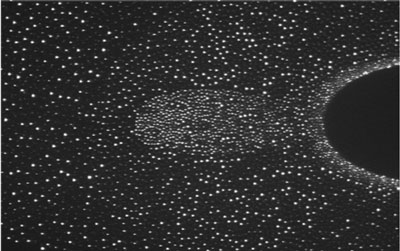| Posted: January 27, 2010 |
Plasma Experiment celebrates Max-Planck-Institute anniversary on board ISS |
|
(Nanowerk News) On 27th January 2010 the 25th series of experiments studying complex plasmas will start on board the international space station ISS. Physicists from the Max-Planck-Institute for extraterrestrial Physics in Garching, Germany, will use them to study fundamental structure forming processes to better understand what happens in liquids and solids.
|
|
That matter exists in three states is widely known: as solid, liquid or gas. Our Universe, however, is dominated by a fourth state of matter: plasma. This forms, if a gas is heated to very high temperatures, so that its molecules dissociate in ions and free electrons. A plasma is regarded as the most disorganised state of matter. Researchers at the Max-Planck-Institute for extraterrestrial Physics, however, have found that under certain conditions plasmas can become liquid or may even crystallise. These are called “complex plasmas” and allow new insights into the physics of liquids and solids. Plasma physicists use them to study melting and crystallisation, motion of lattice defects in crystals, or liquid effects and other processes by looking at single atoms.
|
 |
| Phase separation (droplet formation) in a binary complex plasma on board the ISS.
|
|
Complex plasmas consist of tiny particles (about one thousandth of a millimetre) that are suspended in a plasma and carry a highly negative electric charge. Due to the strong interaction between the particles, they can form regular structures, either liquid or solid. Since Earth´s gravitational field interferes with these processes, experiments with complex plasmas are carried out in space.
|
|
Research on complex plasmas with the PKE-Nefedov laboratory in 2001 was the first science project on board the international space station ISS and the most successful one during the first years. Its successor PK-3 Plus has already been running for four years and provides again unique results. The new series of experiments, carried out from 27th to 29th January is already the 25th mission to study complex plasmas in the absence of gravity. Moreover, PK-3 Plus has now been installed permanently in the new ISS module MIM-2, and will be its first scientific experiment.
|
|
One of the experiments in the PK-3 Plus laboratory will deal with “binary” complex plasmas: if two kinds of particles with different sizes are suspended in a homogeneous plasma, one could expect them to mix due to mutual repulsion. Previous experiments on board the ISS, however, have shown a clear phase separation of the two particles clouds (see figure 2).
|
|
“This phenomenon is well known from many different systems, such as molecular liquids or colloidal suspensions, and has been studied for a long time,” says Hubertus Thomas, MPE-scientist and coordinator of the PK-3 Plus experiments. “In complex plasmas, for the first time we can now study these processes looking at the movement of individual particles and we hope that our latest experiments will lead to new insights into the physics of phase separation.”
|
|
The study of complex plasmas is interdisciplinary, fundamental research. As in other fundamental research before, however, this work initiated a new approach in applied research: the results and experience gained with the plasma experiments on board the ISS and in the lab led to a new medical field, the so-called plasma medicine. Currently a clinical trial is carried out to study how plasmas can be employed for contact-free sterilisation of wounds, hand disinfection in clinical environments or treatment of gingivitis.
|

